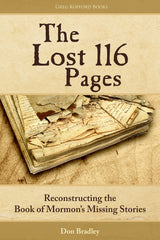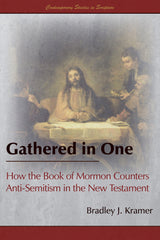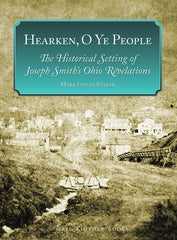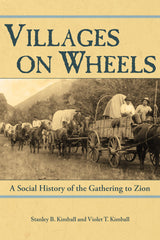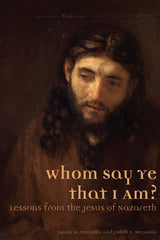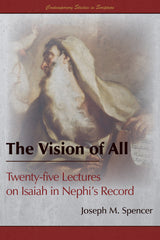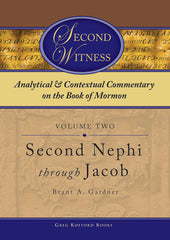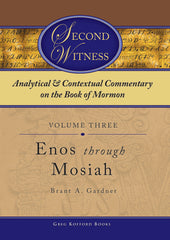News
New Year's Ebook Flash Sale December 27 2021
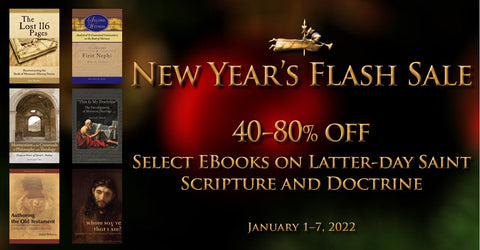
As we welcome 2022, we are pleased to offer discounted prices on select ebooks on scripture and doctrine. This sale runs from January 1–7 and is available for Kindle and Apple ebooks.
Sale ends Friday, Jan 7.
|
|
Scripture |
|
|
$27.99 |
$29.99 |
$29.99 |
|
$29.99 |
$29.99 |
$29.99 |
|
$29.99 |
$22.99 |
|
|
$18.99 |
$25.99 |
$27.99 |
|
$17.99 |
$20.99 |
$17.99 |
|
$22.99 |
$9.99 |
|
|
$22.99 |
$23.99 |
|
|
|
Doctrine |
|
|
$16.99 |
$16.99 |
|
|
$23.99 |
$23.99 |
|
|
$22.99 |
$9.99 |
|
|
$16.99 |
$22.99 |
|
|
$18.99 |
$22.99 |
Q&A with Joseph M. Spencer, author of The Anatomy of Book of Mormon Theology November 14 2021
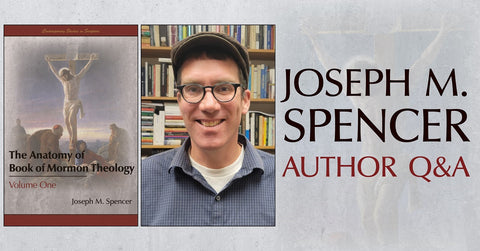
Joseph M. Spencer, November 2021
New Year's Ebook Flash Sale December 29 2020

As we welcome 2021, we are pleased to offer discounted prices on select ebooks on scripture, doctrine, and community. This sale runs from January 1–4 and is available for both Kindle and Apple ebooks.
Sale ends Monday, Jan 4.
Doctrine| Scripture | ||
|
$17.99 |
$27.99 |
$22.99 |
|
$18.99 |
$22.99 |
$23.99 |
| Doctrine | ||
|
$30.99 |
$17.99 |
$9.99 |
|
$26.99 |
$16.99 |
$18.99 |
| Community | ||
|
$18.99 |
$14.99 |
$18.99 |
|
$23.99 |
$18.99 |
$9.99 |
2020 Holiday Gift Guide November 11 2020
This holiday season, we are focusing on themes of scripture, doctrine, and community. Below is a holiday buyer's guide highlighting a few of our most popular titles.
To see our Black Friday Sales, click here.
Scripture
 |
With the Doctrine & Covenants being the 2021 focus for Come Follow Me, Mark Lyman Staker's award-winning history, Hearken, O Ye People, is the perfect gift for those interested in the historical context behind the revelations Joseph Smith received in Ohio. A perfect compliment to your Come Follow Me study. |
 |
One of our most popular titles! The Lost 116 Pages does more than tell the history behind the missing manuscript pages from the early translation of the Book of Mormon, it also uses the best scholarly tools available to analyze internal and external evidence and piece together what may have been in the lost pages. The result tells us as much about the existing Book of Mormon as it does the lost pages. Perfect for those who enjoy taking deep dives into scripture and history! |
 |
Award-winning Book of Mormon scholar, Brant Gardner, looks at Joseph Smith's translation process of the Book of Mormon. The Gift and Power analyzes not only the mechanics of the translation process, but also asks how closely Joseph Smith followed the original Nephite writings. This is the perfect book for those interested in how the Book of Mormon was produced, affirming that it is an ancient text miraculously brought forth by the gift and power of God. |
 |
The Second Witness series by Brant Gardner is lauded as the most comprehensive Book of Mormon commentary in existence. Brant uses his extensive knoweledge and backgroud into Mesoamerican anthropology and intertextual studies to bring the Book of Mormon to life for modern readers. Second Witness can be purchased as a set or individual volumes. A must have for the serious student of the Book of Mormon. |
 |
Authoring the Old Testament launched our Contemporary Studies in Scripture series, which utilizes the best tools of biblical scholarship to speak to a Latter-day Saint audience. Authoring the Old Testament introduces Latter-day Saint readers to the documentary hypothesis and offers a faith-affirming approach to Hebrew Bible authorship in line with contemporary scholarship. |
 |
Continuing with the Contemporary Studies in Scripture series, The Vision of All by Joseph Spencer has been a consistent top seller. The Vision of All analyzis Nephi's use of Isaiah writings in the Book of Mormon, offering a reader-friendly explanation of these challenging prophetic passages. Perfect for readers who want to understand more about Isaiah's writings as well as Nephi's inclusion of them in the Book of Mormon. |
Doctrine
 |
Blake T. Ostler's Exploring Mormon Thought series is the first series ever published by Greg Kofford Books and is still considerd the standard by which faith-affirming Latter-day Saint philosophy is measured. For readers interested in deep philosophical questions regarding the nature of God, human agency, mankind's divine potential, and the problem of evil and suffering in the world, this is the series to get! |
 |
Perhaps of all questions asked about Latter-day Saint doctrine and history, the historic practice of plural marriage is the most divisive. Brian C. Hales's Joseph Smith's Polygamy series is the most in-depth source of research avaiable on the origins of polygamy. Joseph Smith's Polygamy: Toward a Better Understanding, condenses this research into a reader-friendly format. This is essential reading for those who want to better understand the topic of plural marriage while affirming their belief in Joseph Smith's prophetic calling. |
 |
In For Zion, Joseph M. Spencer, assistant professor of ancient scripture at Brigham Young University, picks up where Hugh Nibley's Approaching Zion left off. In this approachable and inspiring text, Joseph expands the concept of consecration beyond the material and economic into one of transformation of the human heart. An excellent book for those who enjoy Latter-day Saint teachings about the promise of Zion and the writings of High Nibley. |
 |
Considered a classic examination of Latter-day Saint doctrine by many, This is My Doctrine by Charles R. Harrell looks closely at the development of key Latter-day Saint teachings and the ongoing conversation between ancient belief and modern-day revelation. This book challenges its readers to see God's hand at work in the evolving nature of doctrine. The perfect book for those who enjoy studying Latter-day Saint doctrine and belief. |
Community
| One of our most popular titles, Bridges by David B. Ostler, speaks to faithful members about the topic of faith crisis. The book takes an empathetic approach, teaching its readers how to build bridges of compassion and understanding with those whose faith has been challenged by historical or social issues within the Church. Read widely by teachers of Church Seminaries and Institutes, Bridges is a must-have for anyone who knows of family members, friends, or ward members who struggle with faith. | |
 |
Miracles Among the Rubble by Carol R. Gray is one of the most loved books by reviewers. In heart-wrenching and inspiring chapters, written with her poetically unique style of expression, Carol shares her experiences of organizing and transporting relief aid for victims of the Balkan War during the early 1990s. Her stories are a testament to the extraordinary achievements of an ordinary mother, who was able to do remarkable things with nothing more than unwavering faith, the help and guidance of the Holy Ghost, and her relationship with the Savior. |
 |
A best-seller, Women at Church by Neylan McBaine has been passed along to numerous local ward and stake leaders who seek ways to more fully include women at the local level. This eye-opening book is perfect for anyone who would like to better understand why many Latter-day Saint women feel marginalized in church settings and what can be done to improve women's visibility and voices in wards and stakes without challenging current doctrine or policies. |
 |
Whom Say Ye That I Am? by James and Judith McConkie utilyzes up-to-date historical scholarship to explore Jesus in the context of first-century Palestine and Jewish culture. This book helps Latter-day Saint readers better understand the life and ministry of Jesus of Nazareth, and how he responded to social institutions and issues in his day, all of which is still relevant to a modern audience. Perfect for readers who enjoy historical Jesus scholarship. |
 |
Although united in faith, members of The Church of Jesus Christ of Latter-day Saints are diverse in their cultural, social, and political perspectives. Common Ground—Different Opinions offers a collection of essays on varying topics from same-sex attraction, femisim, and race, to political partisanship, war, human evolution, and more. This is the perfect book for readers who like to carefully consider arguments from both sides of complex social issues in a ways that maintain civility, respect towards faith, and commitment to the Church. |
 |
The Garden of Enid Vols. 1 and 2 collect Scott Hales's much-loved coming-of-age comic series about fictional teenager, Enid Gardner, as she explores her faith and questions in light of personal and cultural challenges. Funny, charming, sincere, and moving, The Garden of Enid is perfect for teens or anyone who remembers what it was like to be an akward teenager wondering where they fit into the world and the Gospel. |
FLASH SALE: Award-winning Latter-day Saint books — 30% off retail prices! September 23 2020

We are proud of our authors and books! Expand your collection of biographies and narrative histories, anthologies and personal essays, and scripture scholarship with these award-winning titles below. Now 30% off through the end of September.
Sale ends Wednesday, 9/30/2020*
|
2020 Best Biography, JWHA $24.95 |
2018 Best Anthology, JWHA $22.95 |
2017 Best International History, MHA $39.95 |
|
2016 Best Literary Criticism, AML $18.95 |
2016 Best Religious Non-fiction, AML $20.95 |
2016 Best Biography, JWHA $39.95 |
|
2015 Best Religious Non-fiction, AML $34.95 |
2015 Best Book Award, MHA $32.95 |
2015 Best International History, MHA $24.95 |
|
2014 Best Religious Non-fiction, AML $20.95 |
2014 Best International Book, MHA $34.95 |
2013 Best International History, MHA $29.95 |
|
2012 Best Biography, MHA $31.95 |
2012 Best Criticism Award, AML $34.95 |
2011 Best Book Award, MHA & JWHA $34.95 |
|
2007 Best Book Award, JWHA $31.95 |
2003 Best Biography, MHA $32.95 |
1988 Best Book Award, MHA $31.95 |
*For international print orders, email order@koffordbooks.com. Subject to available supply.
Church History and Doctrine Sale: 30% off Select Titles in Print and Ebook April 15 2020
Brush up on your studies of Latter-day Saint history and doctrine with informative and insightful research and explorations. Now 30% off for both print and ebook through Memorial Day.*
Sale ends Monday, 5/25/2020
|
$32.95 |
$34.95 |
$29.95 |
|
$32.95 |
$19.95 |
$31.95 |
|
$26.95 |
$24.95 |
$30.95 |
|
$31.95 |
$14.95 |
*For international print orders, email order@koffordbooks.com. Subject to available supply.
Spring Flash Sale: Up to 88% off Select Ebooks March 24 2020
Stay at home with a great book and help take the pressure off delivery services by going paperless. From now through Easter, download select ebook titles for 30% to 88% off regular price.
Sale ends Monday, 4/12/2020
****NOTE: Due to an error, the discounts for the Kindle ebooks of Second Witness volumes 5 and 6 were not applied. They should be available at the discounted rate by Sunday*****
Insightful messages on justice, mercy, hope, community, and inspiring outlooks on the future during these difficult times. Discounted right now to just $1.99 (up to 88% off regular retail price).
|
$9.95 |
$16.99 |
$16.99 |
The message of Jesus is one of hope and healing. Spend time contemplating the life and mission of the Savior with thought-provoking and inspiring scholarship. Discounted right now to 50% off regular retail price.
|
$23.99 |
$9.99 |

$22.99 |
The Book of Mormon proclaims another witness of the mission of Jesus Christ. Deepen your knowledge and understanding of this sacred book with studies that explore its text, history, and origins. Discounted right now to 30% off regular retail price.
|
$25.99 |
$17.99 |
$20.99 |
|
$22.99 |
$17.99 |
$27.99 |
|
$27.99 |
$22.99 |
$9.99 |
|
$29.99 |
$29.99 |
$29.99 |
|
$29.99 |
$29.99 |
|
Q&A with Don Bradley, author of The Lost 116 Pages: Reconstructing the Book of Mormon's Missing Stories December 09 2019
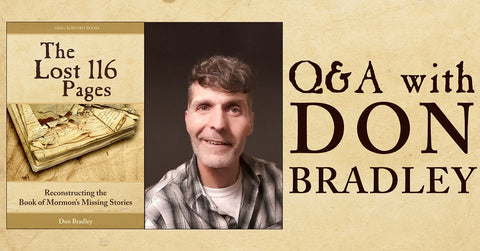
| Download a free sample preview | Order your copy |
For readers less familiar with the "lost 116 pages" can you provide a brief synopsis of what they were and how they became lost?
After Joseph Smith dictated to scribes the first four and half centuries of the Book of Mormon’s chronicle of ancient Jewish settlers in the New World (the Nephites), the manuscript of this account was borrowed by the last of those scribes, Martin Harris. The manuscript later disappeared from Harris’s locked drawer and has been lost to history ever since. The current Book of Mormon text is therefore incomplete, substituting a shorter account for this lengthy missing narrative.
Can you piece together what most likely happened to this lost early manuscript? Does the standard narrative that Lucy Harris likely destroyed them hold up? If not, why and what other possibilities should we consider?
When the manuscript disappeared, Martin Harris initially suspected his wife of the theft. Lucy Harris had been skeptical of her husband’s investment in the book and would have had motive to interfere. Lucy Harris has been regarded as the prime suspect in the theft since the late 1800s, and it has been widely presumed that she burned the manuscript. However, the explanation that Lucy Harris burned the manuscript was first proposed as only a speculative possibility a quarter-century after the fact, but the dramatic image of the disgruntled wife throwing the pages into the flames quickly caught fire and became increasingly popular with time. The further the historical sources get from the actual theft, the more likely they are to tell this story, indicating that it was the story’s sensationalism, rather than its accuracy, that led to its popularity. The first person to have suspected Lucy Harris of the theft, her husband Martin, abandoned this theory when he learned that his estranged but devout Quaker wife had denied on her deathbed knowing what happened to the pages.
The presumption that Lucy Harris stole the pages, acted alone in doing so, and burned them has prevented investigators from looking closely at other suspects, including a number of people who had previously attempted to steal other documents and relics associated with the Book of Mormon. Former treasure digging associates of Joseph Smith had attempted several times to steal the original Book of Mormon—the golden plates. And Martin and Lucy Harris had a son-in-law, a known swindler, who once stole the “Anthon transcript” of characters copied from the plates. Fixating on Lucy Harris as the only possible thief has blinded inquirers to noticing these obvious suspects.
Despite the widespread presumption that Lucy Harris was guilty of taking and burning the manuscript, the manuscript’s ultimate fate is an open question.
You assert that the lost early manuscript might have been longer than 116 pages. Can you provide some reasoning for this? Can you also speculate on how long they may have been?
The number given for the length of the lost manuscript—116 pages—exactly matches the length of the “small plates” text that replaced that manuscript. This coincidence has led several scholars, beginning with Robert F. Smith, to propose that the length of the lost manuscript was actually unknown and the 116 pages figure was just an estimate based on the length of its replacement.
While we can’t know for sure the length of the lost manuscript, unless it turns up, we can do better than just guessing at its actual length, because we have several lines of evidence for this, all of which converge on a probable manuscript size. Joseph Smith reported that Martin scribed on the lost manuscript over a period of 64 days, which, given Joseph’s known translation rate would have produced a manuscript far larger than 116 pages. In line with this, Emer Harris, ancestor to a living Latter-day Saint apostle and brother to Martin Harris, reported at a church conference that Martin had scribed for “near 200 pages” of the manuscript before it was lost. A later interviewer recounted Martin himself reporting a similar scribal output when stating what proportion of the total Book of Mormon text he recorded. Since Martin was not the only scribe to work on the now-lost manuscript but, rather, the fifth such scribe, the manuscript as a whole would have been well in excess of the nearly 200 pages produced by Martin, likely closer to 300 pages. Other lines of evidence within the existing Book of Mormon text point to a similar length for the lost portion.
What sources are used in this book to identify what was in the Book of Mormon's lost 116 pages?
To reconstruct the Book of Mormon’s lost stories this book makes use of both internal sources from within the current Book of Mormon text and external sources beyond that text. Internal sources from the Book of Mormon include, first, accounts from the narrators of the small plates of Nephi, which cover the same time period as the lost portion of Mormon’s abridgment, and, second, narrative callbacks in the surviving remnants of Mormon’s abridgment that refer to the lost stories. External sources used in the reconstruction include statements in the earliest manuscripts of Joseph Smith's revelations describing and echoing the lost pages, statements by Joseph Smith reported by apostles Franklin D. Richards and Erastus Snow, an 1830 interview granted by Joseph Smith, Sr., a conference sermon by Martin Harris’s brother Emer Harris, and reports by several other early Latter-day Saints and friends of Martin Harris.
Can you provide a few examples of how your research into the lost early manuscript has increased your awareness of a Jewish core in the Book of Mormon text?
The research that went into this book has disclosed to me a Jewishness to the Book of Mormon that I could never have imagined. Through the lens of the sources on the lost manuscript, we can see the Jewishness in the Book of Mormon from the very start: according to Joseph Smith, Sr., the lost pages identified the Book of Mormon as beginning with a Jewish festival, namely, Passover. This Jewishness is particularly striking in the sources on the lost manuscript’s narrative of the book’s founding prophets Lehi and Nephi. Their narrative begins in that of the Hebrew Bible, at the start of the Jewish Exile. The recoverable lost-manuscript narratives of Lehi and Nephi show them seeking to build a new Jewish kingdom in the New World systematically parallel to the pre-Exile Jewish kingdom in the Old World. Having lost the biblical Promised Land, sacred city, dynasty, temple, and Ark of the Covenant, they set about re-creating these by proxy.
This Jewishness in the Book of Mormon is paralleled by a distinct Jewishness of the Book of Mormon’s coming forth. Reconstructing a chronology of the several earliest events in the Book of Mormon’s emergence shows every one of these events to have been keyed to the dates of Jewish festivals. In ways not previously appreciated, the Book of Mormon is a richly and profoundly Judaic book.
In your book, you discuss temple worship among the Nephites. Can you summarize some of your findings?
Temple worship stands at the center of Nephite life and of the Book of Mormon’s narrative. The early events of Nephite history, as chronicled in the present Book of Mormon text and fleshed out further in the sources on the book’s lost manuscript, all build toward the ultimate goal of re-establishing Jewish temple worship in a new promised land. Re-establishing such worship required constructing a system closely parallel to that of Solomon’s temple. To meet the requirements of the Mosaic Law, the Nephites would have needed substitutes for the biblical high priest and Ark of the Covenant, with their associated sacred relics. Accordingly, the Nephite sacred relics—the plates, interpreters, breastplate, sword of Laban, and Liahona—systematically parallel the relics of the biblical Ark and high priest, showing how closely temple worship in the Book of Mormon was modeled on temple worship in the Bible.
In what ways are the doctrines in the early lost Book of Mormon manuscript reflected in the doctrines of early Mormonism?
Earliest Mormonism has sometimes been understood as primarily a form of Christian primitivism, the New Testament-focused nineteenth-century movement to restore original Christianity. Yet already when we explore the earliest Mormon text, the lost portion of the Book of Mormon, we find a whole-Bible religion, one weaving Christian primitivist, Judaic, and esoteric strands into a distinctively Mormon restorationist tapestry of faith.
The Book of Mormon’s focus on the temple is also very Mormon. Temple worship among the Nephites not only echoes ancient Jewish temple worship, but it also anticipates temple worship among the Latter-day Saints. The recoverable narratives of the Book of Mormon’s lost pages portray the Nephite temple as not only a place in which sacrifices are performed but also one in which higher truths are taught in symbolic form, human beings learn to speak with the Lord through the veil, and people can begin to take on divine attributes.
What are you hoping readers will gain from your book?
This book’s earliest seed was my childhood curiosity about the Book of Mormon’s lost pages. That seed grew in adulthood when I realized how knowing more about the Book of Mormon’s lost pages could illuminate its present pages. On one level, this new book is a book about the Book of Mormon’s lost text, pursuing the mystery of what was in the lost first half of Mormon’s abridgment. On another level, this is a book about understanding more deeply the Book of Mormon text we do have, since the last half of any narrator’s story is best understood in light of the first half. Researching what can be known about the lost manuscript has helped me to more fully recognize the Book of Mormon’s richness, understand its messages and meanings, and grasp its power as a sacred text. My hope is that recapturing some of the long-missing contexts behind our Book of Mormon will also expand others’ understanding of and appreciation for this remarkable foundational scripture of Latter-day Saint faith and inspire readers to delve deeper into the Book of Mormon.
Don Bradley
December 2019
Christmas Gift Sale: 30% off select titles! November 29 2019

Christmas Gift Sale: 30% off select titles*
Looking for the perfect gifts for the book lover in your life? Get 30% off select titles now through Dec 18.
**Free pickup is available for local customers. See below for details.**
Sale ends Wednesday, 12/18/2019
|
$20.95 |
$21.95 |
$27.95 |
|
|
$26.95 |
$21.95 |
$19.95 |
|
|
$20.95 |
$27.95 |
$25.95 |
|
|
$26.95 |
$34.95 |
$34.95 |
|
|
$20.95 |
$19.95 |
||
|
$34.95 |
$36.95 |
$29.95 |
|
|
$34.95 |
$15.95 |
||
|
$39.95 |
$39.95 |
$39.95 |
|
|
$49.95 |
$39.95 |
$39.95 |
|
|
|
COMPLETE SET $249.70 |
FREE PICKUP FOR LOCAL CUSTOMERS
Enter PICKUP into the discount code box at checkout to avoid shipping and pick up the order from our office in Sandy, Utah.
Pickup times available by appointment only. Email order@koffordbooks.com to schedule your pickup time.
*Offers valid for U.S. domestic customers only. Limited to available supply.
Q&A with Bradley Kramer, author of Gathered in One: How the Book of Mormon Counters Anti-Semitism in the New Testament September 16 2019
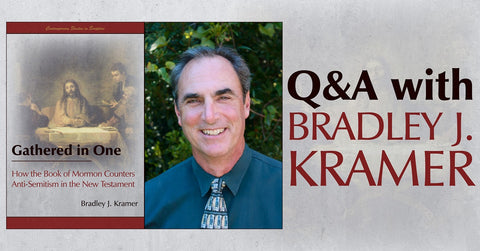
| Download a free sample preview | Order your copy |
Q: For some, hearing that the New Testament contains anti-Semitic language can be challenging. Can you provide a few examples of anti-Semitic rhetoric in the New Testament?
A: Yes. However, first I would like to clarify that I do not think that the New Testament as a whole is anti-Semitic. I do think that the New Testament contains many anti-Semitic statements, anti-Semitic portrayals, anti-Semitic settings, and anti-Semitic structuring elements that together form a kind of literary tide that pulls its readers towards an anti-Semitic point of view, but that is not the same as saying the entire New Testament is anti-Semitic or that anti-Semitism is its major theme.
The Gospel of John, for instance, not only contains a statement where “the Jews” are told that their father is the devil (John 8:44), but they are portrayed explicitly as questioning Jesus (2:18), as accusing him of being in league with the devil (8:48), and as instilling fear in his followers (7:13; 19:38; 20:19). In this Gospel, “the Jews” function as a foil to everything Jesus stands for and teaches. They are from beneath while Jesus is from above; they are of this world while Jesus is not (8:22-23), and they, unlike the enlightened Jesus, love “darkness rather than light, because their deeds are evil” (3:19).
The Gospel of Matthew reinforces this view of Jews through its portrayal of Pharisees. In this Gospel, Pharisees are hypocritical (Matt. 16:3), judgmental (9:11), rule-bound (12:2), scheming (v.14), stupid (v. 24), sign-seeking (v. 38), superficial (15:1), easily offended (v.12), spiritually blind (v. 14), corrupt (12:33), petty (23:23), tricky (22:15), prideful (16:6), and murderous (12:14). True, the Pharisees are only a subgroup of Jews, but without many examples of other subgroups acting differently, they seem to represent Jews as a totality.
In addition, the Gospel of Matthew uses settings to undermine the viability and validity of Jewish practices. The Last Supper, for instance, is set as a Passover Seder and shows Jesus commenting on two of its most important elements: the bread and the wine. However, in this Gospel, the Mosaic meanings of these elements are not mentioned or discussed as stipulated by the Law of Moses (Ex. 12:25–27). Instead, they are presented simply as food items that have lost their Mosaic meaning and can, therefore, be easily repurposed as memorials of Jesus’s soon to-be-dead body and spilt blood. In this way, the Gospel of Matthew presents Passover, much like the Jews themselves, as something devoid of true spirituality and in need of replacement.
Q: Is there scholarly consensus regarding anti-Semitism in the New Testament? Can you provide examples of scholarly debate on the topic?
A:I think so, yes. Many scholars, however, prefer to use the term “anti-Judaic,” feeling that the New Testament attacks Jews more as members of a certain faith, which can change, than as members of an ethnic or genetic group, which cannot. I have elected to use “anti-Semitic” in my book because 1) most of my sources use that term, 2) “anti-Semitic” is the more common, inclusive term, and 3) in practice the distinction between these two approaches is not always clear—even in the New Testament. Jesus in the Gospel of John, for instance, does not tell “the Jews” that the devil is their spiritual leader; he says that the devil is their “father” (John 8: 44). Similarly, in Matthew the Jewish multitude cries out for his blood to be upon their “children, not upon their religious descendants (Matt. 27:25).
Scholars, as well as many devoted Christian ministers, are disturbed by this scene in the Gospel of Matthew. It seems to brand all Jews throughout time as “Christkillers” and has been used to justify numerous anti-Jewish atrocities. As a result, many of these scholars, ministers, and laypeople deny that it ever happened. They point out that there is no record of any Roman governor ever releasing prisoners on Passover and question the logic of such a custom. After all, why would a Roman official charged with keeping the peace run the risk of releasing his most dangerous enemies back into society? It makes no sense.
These scholars and ministers similarly dispute the Gospels’ portrayal of Pilate as a spiritually ambivalent government official who could be swayed by the voice of a Jewish multitude. According to Roman records, not only did Pilate place Roman images inside the Temple precincts in direct opposition of the will of his subjects, but he also confiscated Temple funds when they refused to pay their taxes. Furthermore, when people gathered before him to protest, he had his soldiers disguise themselves, infiltrate the crowd, and slaughter them all.
The majority of scholars and ministers see Pilate as a merciless ruler who would have had no qualms whatsoever about crucifying Jesus. However, by doing so, Pilate presented early Christians with a problem. After all, they had to live and work and worship within the Roman Empire. It would not be wise to paint a Roman official as a murderer, particularly as the murderer of the Son of God. Many scholars and ministers, therefore, see this scene as a fictional embellishment designed to shift the blame for Jesus’s death from the Romans to the already despised Jews.
Q: Can you provide an example or two of how the Book of Mormon counters anti-Semitism in the New Testament?
A: I can think of no more powerful condemnations of anti-Semitic behavior than these:
O ye Gentiles, have ye remembered the Jews, mine ancient covenant people? Nay; but ye have cursed them, and have hated them, and have not sought to recover them. But behold, I will return all these things upon your own heads; for I the Lord have not forgotten my people. (1 Ne. 29:5)
Yea, and ye need not any longer hiss, nor spurn, nor make game of the Jews, nor any of the remnant of the house of Israel; for behold, the Lord remembereth his covenant unto them, and he will do unto them according to that which he hath sworn. (3 Ne. 29:8)
Furthermore, these are not simply official declarations issued by a church or statements from an ecclesiastical leader. In the former, it is God who chastises non-Jews (probably Christians) for persecuting Jews; and in the latter, it is Mormon, a prophet of God, who commands these same Christians to cease oppressing the Jews.
Also, notice that these condemnations do not comment upon any particular passage in the New Testament, nor do they challenge the veracity of any specific New Testament event. However, given their clarity of expression, they make it very difficult for Christians to interpret the New Testament anti-Semitically.
In this way, the Book of Mormon does not change the New Testament’s words or call into question their ability to convey divine messages to their readers directly. However, for believers, it alters how the New Testament’s words are understood. When joined with the New Testament in the Christian canon, the Book of Mormon overwhelms the anti-Semitic statements, portrayals, settings, and structural elements with more numerous and more sweeping pro-Jewish statements, portrayals, settings, and structural elements of its own. In this way, the Book of Mormon turns the literary tide in the New Testament and causes it to flow in the opposite direction.
Q: How does the Book of Mormon limit Jewish involvement in Jesus’ death?
A: For the most part, the prophets in the Book of Mormon seems more interested in what Jesus’s death accomplished than in who killed him. Nephi, for instance, recounts his vision of Jesus’s death saying only that Jesus “was lifted up upon the cross and slain for the sins of the world” without specifying who did the lifting (1 Ne. 11:33), and Abinadi similarly prophecies that Jesus will be “led, crucified, and slain” again without mentioning who will do the leading, crucifying, and slaying (Mosiah 15:7). The same is true for Samuel the Lamanite (Hel. 13:6) and even Jesus (3 Ne. 11:14).
Furthermore, when these prophets do attempt to identify Jesus’s killers, they use vague terms such as “the world” or “wicked men” (1 Ne. 19:7–10), or they employ phrases that, while they may appear at first to indict all Jews everywhere, actually absolve the majority of Jews of any involvement whatsoever in Jesus’s death. Jacob’s “they at Jerusalem” (2 Ne. 10:5), for example, may seem to some readers to indicate that all Jews participate somehow in Jesus’s crucifixion. These readers link this phrase with “the Jews” in verse 3 and see it as affirming universal Jewish culpability regarding Jesus’s death. However, during Jesus’s lifetime, only a small percentage of the world’s Jews lived in Jerusalem. During that time, most Jews were still residing in Babylon or were scattered throughout the eastern Mediterranean and beyond—as Jacob, who as one of the most far-flung of these Jews, knew very well.
In other words, instead of serving as a synonym of “the Jews,” “they at Jerusalem” functions as the last element in a grammatical sequence that shrinks the number of Jews connected to Jesus’s death from all Jews everywhere to “those who are the more wicked part of the world” to just those Jews living in Jerusalem during the early first century. In a similar way, 2 Nephi 10 also softens “they shall crucify him” of verse 3 to “they . . . will stiffen their necks against him, that he be crucified” and complicates their complicity by stating in verse 5 that they do so not because of some deep-seated personal conviction but “because of priestcrafts and iniquities.”
Q: What is supersessionism and how does the Book of Mormon refute it?
A: Supersessionism is the traditional Christian doctrine that the Jews have been disobedient for so long, failing to follow their own law as well as murdering its originator (Jesus), that their covenantal connection to God has been revoked and they have been replaced by Christian Gentiles. Statements in the Book of Mormon clearly refute this notion by confirming that the Jews remain God’s “covenant people” (2 Ne. 29:4–5) even after Jesus’s death (Morm. 3:21), and by affirming that despite being scattered “upon all the face of the earth,” the Jews will one day be “armed with righteousness and with the power of God in great glory” (1 Ne. 14:14), that they will be delivered from their enemies (2 Ne. 6:17), and that pure people everywhere will seek “the welfare of the ancient and long dispersed covenant people of the Lord” (Morm. 8:15).
In addition to these statements, the portrayal of the Nephites and Lamanites further reinforces the Jews’ ongoing covenantal connection to God. In the Synoptic Gospels, Jews, as Pharisees, are portrayed as so hypocritical and murderous (at least towards Jesus) that it is hard to see them as continuing in God’s covenant. In the Book of Mormon, Nephites also struggle with hypocrisy as do the Lamanites with murder, and yet never are these New World Jews removed from God’s covenant or detached from God’s care. Missionaries go to them, and often they repent, but even when they do not and their civilization disintegrates into self-destructive chaos, God continues to seek after their descendants and sees them always as heirs to the covenantal promises given to Abraham, Isaac, and Jacob.
Q: How should Latter-day Saints relate to Jews?
A: With charity, just like Nephi (2 Ne. 33:8), and not as potential converts. It is significant that the Book of Mormon never uses the words “convert” or “conversion” in connection with Jews. Instead, it employs “persuade” and “convince,” and presents Jesus as the only person authorized to do this persuading and convincing. As he tells the Nephites:
And then will I gather them in from the four quarters of the earth; and then will I fulfil the covenant which the Father hath made unto all the people of the house of Israel. . . . And then will I remember my covenant which I have made unto my people, O house of Israel, and I will bring my gospel unto them. (3 Ne. 16:5, 11)
This repetition of the pronoun “I” in this passage and in 3 Ne. 21:1 indicates to me that Christians should not press Jews to accept Jesus. They should instead have enough faith in their Master to let him do what he has covenanted to do without any help or interference from them.
Christians should embrace Jews as brothers and sisters in God’s covenant, as true friends with whom they can talk, play, work, worship, hang out, enjoy, and learn from, especially in regards to the Scriptures. As Nephi reminds his readers:
I know that the Jews do understand the things of the prophets, and there is none other people that understand the things which were spoken unto the Jews like unto them, save it be that they are taught after the manner of the things of the Jews. (2 Ne. 25:5)
Q: What are you hoping readers will gain through this book?
A: I hope my readers will see more clearly just how the Book of Mormon can augment and enhance the Bible without undermining its scriptural authority or reliability. I hope they will also feel a closer, more informed, more appreciative connection with Jews. I think many Christians are fairly ignorant about Jews and are somewhat split in their opinion of them. Through movies such as “Schindler’s List,” “Denial,” and “The Pianist,” they may feel sympathetic towards Jews because of persecutions they have suffered and the pains they have endured. However, because of the New Testament, they may also be inclined to see Jews as chronic nitpickers who hypocritically follow superficial religious practices.
With this book, I hope to resolve this difference by showing my readers that there is more to the Jews than is offered in the New Testament, that Mosaic practices remain relevant today, that the Law of Moses has been observed admirably by an admirable people; and that Jews have much to teach Christians religiously, ethically, and scripturally. They certainly have taught me much.
Bradley J. Kramer
September 2019
Book of Mormon Flash Sale: 40%-64% off! September 20 2018
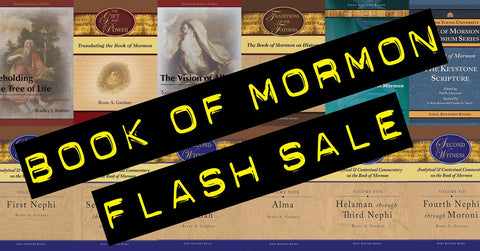
Friday, Sep 21 through Monday, Sep 24
In commemoration of Joseph Smith receiving the golden plates on September 22, 1827, we are pleased to offer a sale on the following Book of Mormon titles:*
Ebooks
|
$20.99 |
$27.99 |
$22.99 |
|
$27.99 |
$9.99 |
Print Books
|
$39.95 |
$39.95 |
$39.95 |
|
$49.95 |
$39.95 |
$39.95 |
|
$34.95 |
|
$129.95 |
*Offer valid for US domestic customers only. Print book sale limited to available supply.
Q&A Part 2 with the Editors of The Expanded Canon: Perspectives on Mormonism & Sacred Texts September 11 2018

Hardcover $35.95 (ISBN 978-1-58958-637-6)
Part 2: Q&A with Brian D. Birch (Part 1)
Q: When and how did the Mormon Studies program at UVU launch?
A: The UVU Mormon Studies Program began in 2000 with the arrival of Eugene England. Gene received a grant from the National Endowment for the Humanities to explore how Mormon Studies could succeed at a state university. A year-long seminar resulted that included a stellar lineup of consultants and guest scholars. From that point forward, the Religious Studies Program has developed multiple courses complemented by our annual Mormon Studies Conference and Eugene England Lecture—to honor Gene’s tragic and untimely passing in 2001. The program also hosts and facilitates events for independent organizations and publications including the Society for Mormon Philosophy and Theology, the Dialogue Foundation, the Interpreter Foundation, Mormon Scholars in the Humanities, Association for Mormon Letters, and others.
Q: How is the UVU Mormon Studies program distinguished from Mormon Studies programs that have emerged at other campuses?
A: Mormon Studies at UVU is distinguished by the explicitly comparative focus of our work. Given the strengths of our faculty, we have emphasized courses and programming that addresses engagement and dialogue across cultures, faith traditions, and theological perspectives. Permanent course offerings include Mormon Cultural Studies, Mormon Theology and the Christian Tradition, Mormon Anthropology, and Mormon Literature. Our strengths lie in areas other than Mormon history, which is well represented at other institutions—and appropriately so. Given the nature of our institution, our events are focused first and foremost on student learning, but all our events are free and open to the public and we welcome conversation between scholars and nonprofessionals.
Q: How long has the annual UVU Mormon Studies Conference been held, and what have been some of the topics of past conferences?
A: As mentioned above, the Mormon Studies Conference was first convened by Eugene England in 2000, and to date we have convened a total of nineteen conferences. Topics have ranged across a variety of issues including “Islam and Mormonism,” “Mormonism in the Public Mind,” “Mormonism and the Art of Boundary Maintenance,” “Mormonism and the Internet,” etc. We have been fortunate to host superb scholars and to bring them into conversation with each other and the broader public.
Q: Where did the material for the first volume, The Expanded Canon, come from?
A: The material in The Expanded Canon emerged came from our 2013 Mormon Studies Conference that shares the title of the volume. We drew from the work of conference presenters and added select essays to round out the collection. The volume is expressive of our broader approach to bring diverse scholars into conversation and to show a variety of perspectives and methodologies.
Q: What are a few key points about this volume that would be of interest to readers?
A: Few things are more central to Mormon thought than the way the tradition approaches scripture. And many of their most closely held beliefs fly in the face of general Christianity’s conception of scriptural texts. An open or expanded canon of scripture is one example. Grant Underwood explores Joseph Smith’s revelatory capacities and illustrates that Smith consistently edited his revelations and felt that his revisions were done under the same Spirit by which the initial revelation was received. Hence, the revisions may be situated in the canon with the same gravitas that the original text enjoyed. Claudia Bushman directly addresses the lack of female voices in Mormon scripture. She recommends several key documents crafted by women in the spirit of revelation. Ultimately, she suggests several candidates for inclusion. As the Mormon canon expands it should include female voices. From a non-Mormon perspective, Ann Taves does not embrace a historical explanation of the Book of Mormon or the gold plates. However, she does not deny Joseph Smith as a religious genius and compelling creator of a dynamic mythos. In her chapter she uses Mormon scripture to suggest a way that the golden plates exist, are not historical, but still maintain divine connectivity. David Holland examines the boundaries and intricacies of the Mormon canon. Historically, what are the patterns and intricacies of the expanding canon and what is the inherent logic behind the related processes? Additionally, authors treat the status of the Pearl of Great Price, the historical milieu of the publication of the Book of Mormon, and the place of The Family: A Proclamation to the World. These are just a few of the important issues addressed in this volume.
Q: What is your thought process behind curating these volumes in terms of representation from both LDS and non-LDS scholars, gender, race, academic disciplines, etc?
A: Mormon Studies programing at UVU has always been centered on strong scholarship while also extending our reach to marginalized voices. To date, we have invited guests that span a broad spectrum of Mormon thought and practice. From Orthodox Judaism to Secular Humanists; from LGBTQ to opponents to same-sex marriage; from Feminists to staunch advocates of male hierarchies, all have had a voice in the UVU Mormon Studies Program. Each course, conference, and publication treating these dynamic dialogues in Mormonism are conducted in civility and the scholarly anchors of the academy. Given our disciplinary grounding, our work has expanded the conversation and opened a wide variety of ongoing cooperation between schools of thought that intersect with Mormon thought.
Q: What can readers expect to see coming from the UVU Comparative Mormon Studies series?
A: Our 2019 conference will be centered on the experience of women in and around the Mormon traditions. We have witnessed tremendous scholarship of late in this area and are anxious to assemble key authors and advocates. Other areas we plan to explore include comparative studies in Mormonism and Asian religions, theological approaches to religious diversity, and questions of Mormon identity.
Download a free sample of The Expanded Canon
Listen to an interview with the editors
Upcoming events for The Expanded Canon:
Tue Sep 18 at 7pm | Writ & Vision (Provo) | RSVP on Facebook
Wed Sep 19 at 5:30 pm | Benchmark Books (SLC) | RSVP on Facebook
Twelve Days of Kofford 2017 November 21 2017
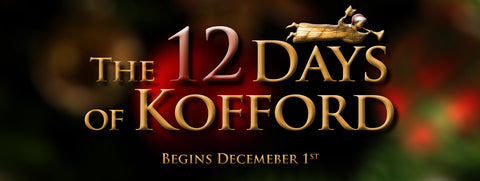
Greg Kofford Books is once again pleased to offer twelve days of discounted holiday shopping from our website!
HERE IS HOW IT WORKS: Every morning from Dec 1th through the 12th, we will be posting a DISCOUNT CODE on our Facebook or Twitter pages. Use this discount code on the corresponding day to receive 30% off select titles. The final day will be an e-book flash sale on Amazon.com.
To help you plan, here are the dates, titles, and sale prices we will be offering beginning Dec 1st. These sales are limited to available inventory. You must follow our Facebook or Twitter pages to get the discount code. Orders over $50 qualify for free shipping. Customers in the Wasatch Front area are welcome to pick orders up directly from our office in Sandy, UT.
Day 1 — Brant Gardner collection
 |
Second Witness, Vol 1: First Nephi $39.95 hardcover |
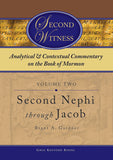 |
Second Witness, Vol 2: Second Nephi through Jacob $39.95 hardcover |
 |
Second Witness, Vol 3: Enos through Mosiah $39.95 hardcover |
 |
Second Witness, Vol 4: Alma $49.95 hardcover |
 |
Second Witness, Vol 5: Helaman through Nephi $39.95 hardcover |
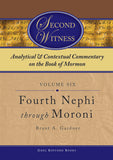 |
Second Witness, Vol 6: Fourth Nephi through Moroni $39.95 hardcover |
 |
The Gift and the Power: Translating the Book of Mormon $34.95 paperback |
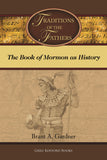 |
Traditions of the Fathers: The Book of Mormon as History $34.95 paperback |
 |
The Garden of Enid: Adventures of a Weird Mormon Girl $22.95 paperback |
 |
The Garden of Enid: Adventures of a Weird Mormon Girl $22.95 paperback |
Day 3 — The Mormon Image in Literature
 |
The Mormoness; Or, The Trials of Mary Maverick: $12.95 paperback |
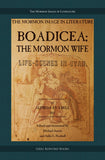 |
Boadicea; the Mormon Wife: Life Scens in Utah $15.95 paperback |
 |
Dime Novel Mormons $22.95 paperback |
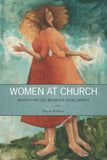 |
Women at Church: Magnifying LDS Women's Local Impact $21.95 paperback |
 |
Mormon Women Have Their Say: Essays from the Claremont Oral History Collection $31.95 paperback |
 |
Voices for Equality: Ordain Women and Resurgent Mormon Feminism $32.95 paperback |
 |
Joseph Smith's Polygamy, Vol 1: History $34.95 paperback |
 |
Joseph Smith's Polygamy, Vol 2: History $34.95 paperback |
 |
Joseph Smith's Polygamy, Vol 3: Theology $25.95 paperback |
 |
Joseph Smith's Polygamy: Toward a Better Understanding $19.95 paperback |
 |
Modern Polygamy and Mormon Fundamentalism: The Generations after the Manifesto $31.95 paperback |
 |
Mormon Polygamous Families: Life in the Principle $24.95 paperback |
 |
Prisoner for Polygamy: The Memoirs and Letters of Rudger Clawson at the Utah Territorial Penitentiary, 1884–87 $29.95 paperback |
 |
Who Are the Children of Lehi? DNA and the Book of Mormon $15.95 paperback |
 |
“Let the Earth Bring Forth”: Evolution and Scripture $15.95 paperback |
 |
Mormonism and Evolution: The Authoritative LDS Statements $15.95 paperback |
 |
Parallels and Convergences: Mormon Thought and Engineering Vision $24.95 paperback |
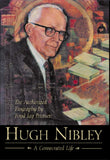 |
Hugh Nibley: A Consecrated Life $32.95 hardcover |
 |
“Swell Suffering”: A Biography of Maurine Whipple $31.95 paperback |
 |
William B. Smith: In the Shadow of a Prophet $39.95 paperback |
 |
LDS Biographical Encyclopedia, 4 Vols $259.95 paperback |
 |
The Man Behind the Discourse: A Biography of King Follett $29.95 paperback |
 |
Liberal Soul: Applying the Gospel of Jesus Christ in Politics $22.95 paperback |
 |
A Different God? Mitt Romney, the Religious Right, and the Mormon Question $24.95 paperback |
 |
Common Ground—Different Opinions: Latter-day Saints and Contemporary Issues $31.95 paperback |
 |
Even Unto Bloodshed: An LDS Perspective on War $29.95 paperback |
 |
War & Peace in Our Time: Mormon Perspectives $29.95 paperback |
 |
The End of the World, Plan B: A Guide for the Future $13.95 paperback |
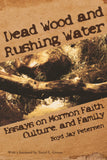 |
Dead Wood and Rushing Water: Essays on Mormon Faith, Culture, and Family $22.95 paperback |
 |
Mr. Mustard Plaster and Other Mormon Essays $20.95 paperback |
 |
Writing Ourselves: Essays on Creativity, Craft, and Mormonism $18.95 paperback |
 |
On the Road with Joseph Smith: An Author's Diary $14.95 paperback |
 |
Hearken O Ye People: The Historical Setting of Joseph Smith's Ohio Revelations $34.95 hardcover |
 |
Fire and Sword: A History of the Latter-day Saints in Northern Missouri, 1836–39 $36.95 hardcover |
 |
A House for the Most High: The Story of the Original Nauvoo Temple $29.95 paperback |
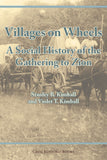 |
Villages on Wheels: A Social History of the Gathering to Zion $24.95 paperback |
 |
Mormonism in Transition: A History of the Latter-day Saints, 1890–1930, 3rd ed. $31.95 paperback |
Day 11 — International Mormonism
 |
Tiki and Temple: The Mormon Mission in New Zealans, 1854–1958 $29.95 paperback |
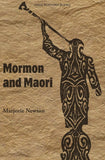 |
Mormon and Maori $24.95 paperback |
 |
The Trek East: Mormonism Meets Japan, 1901–1968 $39.95 paperback |
 |
From Above and Below: The Mormon Embrace of Revolution, 1840–1940 $34.95 paperback |
 |
The History of the Mormons in Argentina $24.95 paperback |
 |
For the Cause of Righteousness: A Global History of Blacks and Mormonism, 1830–2013 $32.95 paperback |
Free Scriptural Theology ebook for newsletter subscribers! October 30 2017
FREE EBOOK FOR NEWSLETTER SUBSCRIBERS
Perspectives on Mormon Theology: Scriptural Theology
Edited by James E. Faulconer and Joseph M. Spencer
Part of the Perspectives on Mormon Theology series
$24.95 FREE FOR OUR NEWSLETTER SUBSCRIBERS (Limited time)
Greg Kofford Books is pleased to offer for a limited time a free ebook version of Scriptural Theology, the first volume in the Perspectives on Mormon Theology series.
This volume is edited by James E. Faulconer and Joseph M. Spencer and seeks to offer a variety of perspectives regarding the nature and meaning of scripture for Latter-day Saints.
Book description:
The phrase “theology of scripture” can be understood in two distinct ways. First, theology of scripture would be reflection on the nature of scripture, asking questions about what it means for a person or a people to be oriented by a written text (rather than or in addition to an oral tradition or a ritual tradition). In this first sense, theology of scripture would form a relatively minor part of the broader theological project, since the nature of scripture is just one of many things on which theologians reflect. Second, theology of scripture would be theological reflection guided by scripture, asking questions of scriptural texts and allowing those texts to shape the direction the theologian’s thoughts pursue. In this second sense, theology of scripture would be less a part of the larger theological project than a way of doing theology, since whatever the theologian takes up reflectively, she investigates through the lens of scripture.
The essays making up this collection reflect attentiveness to both ways of understanding the phrase “theology of scripture.” Each essay takes up the relatively un-self-conscious work of reading a scriptural text but then—at some point or another—asks the self-conscious question of exactly what she or he is doing in the work of reading scripture. We have thus attempted in this book (1) to create a dialogue concerning what scripture is for Latter-day Saints, and (2) to focus that dialogue on concrete examples of Latter-day Saints reading actual scripture texts.
Contributors: James E. Faulconer, Joseph M. Spencer, Robert Couch, Adam S. Miller, Eric D. Huntsman, Claudia L. Bushman, Bruce W. Jorgensen, Jane Hafen, Jenny Webb, George B. Handley
Subscribe to our free newsletter by entering your email address above and receive instructions for downloading your free ebook.
Once you have signed up for our newsletter, you will recieve a welcome email that will provide instructions for downloading the ebook. Please read these instructions carefully. Check your junk folder if you do not see the welcome email.
Q&A with Joseph Spencer for The Vision of All February 27 2017
Order Your Copy Today
Q:How and when did you begin to recognize the need for a different approach to studying the Isaiah sections in the Book of Mormon?
A: Well, I've always been overconfident about what I might be able to accomplish, so I first decided to tackle Isaiah in earnest when I was a teenager. Of course, I understood little, because I knew no real resources. I read carefully through the King James Version of the text, and I followed every footnote in the LDS edition. I spent a whole summer doing that, and I gained little more than some familiarity. I turned to Isaiah again shortly after my mission, when I was taking an introductory course on Hebrew. Studying straight from the Hebrew, using dictionaries and a few other tools, I felt like I came to understand the text a bit better, though I only worked at the time through about five chapters of Isaiah. At about the same time, I discovered a few other scholarly resources, especially the old FARMS volume Isaiah in the Book of Mormon. Those helped orient me in Isaiah's world a bit better, but I wasn't yet doing the sort of thing I've come to do now.
What changed things was twofold. First, my wife, Karen, and I were studying First Nephi, and we struck on some structural features of Nephi's record that make clear he means to emphasize Isaiah above all else in his record. (I've talked about these structural features in my books.) That spurred me to give closer attention to Nephi's treatment of Isaiah than I had before. Up to that point, I'd tried only to approach Isaiah on his own terms, using just a few scholarly resources. But stumbling onto the idea that I could see how Nephi reads Isaiah fired me up. And it got me more interested than before in understanding Isaiah on his own terms as well. I figured that understanding Isaiah himself would allow me to see how Nephi was using him in his own inventive ways. So I began, finally, to read the massive scholarly literature on Isaiah. Second, I was asked to teach early-morning seminary one year, while we were living in Oregon. The course of study was the Old Testament, and I asked for permission to focus the whole year just on Genesis, Job, and Isaiah. The bishop granted it, and so I worked with my students all the way through Isaiah for three months. In preparation for each class discussion, I did nothing but read commentaries, and then we came together and just wrestled with the text of Isaiah. By that point, I was finishing work on my first book, An Other Testament, which is largely about how the Book of Mormon handles Isaiah, so working carefully through every line of Isaiah with my students helped me to see even better how inventive and interesting Nephi is in his reading of Isaiah.
So I suppose it's been a circuitous path. The short answer is that it was only when I saw (a) that Nephi really means to privilege Isaiah and (b) that he deliberately reads Isaiah in his own way that my project began to take shape.
Q: In what ways does Nephi use Isaiah inventively? And how might his usage differ from scholarly consensus on Isaiah's original intent?
A: On my reading, Nephi explicitly tells his readers that he's reading Isaiah inventively. I believe this is what he tries to signal with the word "likening" (see, for example, 1 Ne. 19:23). He sees Isaiah's prophecies as having a meaning of their own, which we might call their immediate meaning. But then he sees the possibility of finding in Isaiah's prophecies a basic pattern that's replicated in Israel's history at times and in places where Isaiah wasn't himself focused. This is clearest when he applies prophecies from the Book of Isaiah, which in their biblical context are clearly about the return of exiled Jews from Babylon during the sixth century before Christ, to things he sees in vision regarding Lehi's descendants in modern times. He explicitly recognizes that passages from Isaiah have their natural fulfillment in the return of Jews from exile to the land of Judah, but then he suggests that the same passages can be likened to the return of latter-day Lamanites to the gospel of Christ their ancestors knew. He seems to see Isaiah as outlining patterns of how God works with Israel, whether in whole or in part, whether anciently or in modern times, again and again. And so he sees the possibility of adapting Isaiah texts to events that arguably outstrip the straightforward meaning of those texts. That is, I think, a rather responsible (because self-aware) form of inventive interpretation.
Of course, such an approach to the Book of Isaiah differs drastically from the kinds of approaches on offer in scholarly work on Isaiah today. For one, Nephi asks a rather different set of questions about Isaiah than do modern scholars. Academic work on Isaiah aims at reconstructing the historical origins and context of the Book of Isaiah, as well as the processes through which what originated with Isaiah came to have the shape we're familiar with from the Bible. Nephi isn't at all interested in these questions. He's apparently familiar with the basic, straightforward historical meaning of prophecies in the Book of Isaiah, but he moves pretty quickly beyond such meanings to explore other possible meanings and applications. Further, though, there are many other ways Nephi seems to differ from the conclusions of modern scholarly work on Isaiah. For instance, he clearly regards the whole of Isaiah 2–5 as a larger unit of text (as can be seen from connecting words and original chapter breaks in the Book of Mormon), but most interpreters today regard those chapters as divisible into at least two larger units (Isaiah 2–4 and Isaiah 5, for example). That only scratches the surface, of course. There are still larger issues of conflict between the way Nephi (or really, the Book of Mormon quite generally) handles Isaiah and the conclusions drawn by modern scholarship, but that would take some work to develop.
Q: How does The Vision of All negotiate this sometimes tense or conflicting terrain of modern scholarship and a more philosophically-grounded reading of Isaiah?
A: First and foremost, I think it's important just to make clear that there are various ways of reading Isaiah, and that Nephi acknowledges the uniqueness of his approach. We're far too prone as Latter-day Saints to think that there's one correct answer to questions about the meaning of a passage of scripture. We tend to think that we're done with a text once we know the "right" interpretation. And, in many ways, that's mirrored in modern scholarship, although modern scholars come up with a very different set of answers about the meanings of Isaiah's writings. The result is that too many academics think that average believers (Mormon or otherwise) simply get scripture wrong, and average believers return the compliment by claiming that scholars in turn get scripture wrong. What Nephi teaches us, I think, is that a given passage of scripture can have a variety of meanings and applications. Meaning is dynamic and contextualized by the act of reading. The result is that there's more a history of interpretation than there's a definite meaning for any particular passage or text. In Nephi's writings we can glimpse Lehi's approach to Isaiah, and it's quite different from Nephi's. And then he sets his own interpretations side by side with Jacob's, which are similar but far from identical. Even within just the sermon Nephi quotes from Jacob in 2 Nephi 6–10, we can track two rather different interpretations of one and the same passage (Isa. 49:22–23).
Just getting clear about all this can help us to feel a good deal more at home with Isaiah. Our job isn't to figure out the one true meaning of Isaiah, but to let Isaiah's words work on us. They provide us with patterns and images, relationships and themes. Our task is to dwell in the text and to let it begin to shape the way we see things. We won't be able to do this very well if we don't become familiar with the range of meanings the text can accommodate. So we ought to read Isaiah scholarship to become familiar with historical reconstructions of Isaiah's (apparent) original meaning. In fact, it's important to read some of this scholarship just to become familiar with the fact that no two interpreters agree on Isaiah's meaning. There are key passages in Isaiah that are literally interpreted in a dozen different ways by major modern interpreters. And then it'd be helpful for us if we became more familiar with the history of interpretation of Isaiah. How have Jews read Isaiah 53? Do different sorts of Christians read Isaiah 11 in different ways? How does a Seventh-day Adventist read Isaiah's references to the remnant by comparison with a mainline Protestant? And then how might we, as Latter-day Saints, find meaning in Isaiah? These are questions that go a good deal further than I ever do in The Vision of All, but I try in the book to open the way to these kinds of approaches, since I argue that Nephi does something like this in his own context.
Q: Can you give us a concrete example of a passage that Latter-day Saints may be prone to interpret a specific way, but which consideration of other interpretations, both within modern scholarship and other religious traditions, may be beneficial?
A: It's probably easiest here just to begin with an example that's decently known already. Most Latter-day Saints are familiar with those passages in Isaiah that play a prominent role in Handel's Messiah. "Behold, a virgin shall conceive, and bear a son, and shall call his name Immanuel" (Isa. 7:14). "For unto us a child is born, unto us a son is given: and the government shall be upon his shoulder: and his name shall be called Wonderful, Counsellor, The mighty God, The everlasting Father, The Prince of Peace" (Isa. 9:6). These kinds of passages are generally understood by average Mormons to be straightforward prophecies of Jesus Christ's birth. Modern scholars, however, generally read these passages in a fundamentally different way, say, as prophecies concerning events that were to happen within Isaiah's own lifetime. Some familiarity with the history of Jewish interpretation also helps to reveal how differently these texts can be read. Even many modern Christians, usually in mainline Protestantism, don't read these passages as direct references to Jesus Christ. It turns out that there are many different ways of making sense of these texts. They can be read as predictions of Jesus's birth. But they can also be read in many other ways, often informatively. Now, I don't mean to suggest that the other ways are necessarily the best ways. They may or may not be. But any reading of these passages will be stronger and more interesting if it acknowledges that it approaches the text from a certain perspective, from the perspective of a certain faith.
And really, that's what matters here, I think. When I say that we can benefit from familiarity with the ways that other traditions or modern scholars read certain passages of Isaiah, I mean that we can grow out of the naive assumption that there's only one possible way to understand a text (an assumption that too easily leads us to think that everyone who doesn't see things our way is simply stupid), and we can grow into a recognition that our readings are rooted in our own system of beliefs. I might put that another way: we can grow out of the naive idea that our interpretations of Isaiah are a matter of straightforward knowledge, and we can grow into the deeply mature realization that our interpretations of Isaiah are a matter of invested faith. Now, I suspect that most who become a bit more familiar with the variety of interpretations of Isaiah will come to interpret some of the texts in a new way. I certainly have as I've studied. And that's good, I think. But I think also that the best readers will also find reasons to defend uniquely Mormon interpretations of many passages of Isaiah, even while recognizing that those interpretations are rooted in a very specific perspective of faith. Why shouldn't we grow all the fonder of interpretations that grow directly out of our faith commitments, even as we recognize that the text can be read in many ways? I think we should, that we should feel free to defend an understanding of Isaiah that's informed by other traditions and scholarly work but that's simultaneously rooted in the Restoration.
Q: Switching topics, let's talk about the style of the book: The Vision of All is laid out as a series of twenty-five classroom-style lectures. Give us some insight into your decision to use this approach and if it had any precedent that inspired you.
A: A few things came together that led me to do the book this way. First, over the past few years, I'd begun to write some of my public presentations in this style, instead of always delivering a more formal or finished paper. I found I really enjoyed the writing process of producing something less formal, something where I don't have to tie up every loose thread and can focus on rhetorical delivery. Experimenting with that form of writing got me thinking. Second, I'd begun teaching courses on the Book of Mormon at Brigham Young University, and I'd found that students responded very well to my lectures on the Isaiah material. These weren't written up even in an informal style, but I began thinking that the sort of presentations I was making in the classroom with Isaiah might be more accessible to Latter-day Saints in general. Finally, I've been working steadily on Isaiah in the Book of Mormon for more than a decade now, and I began to think that I had too many ideas piled up in my head that really needed to be put in writing in some form or another, and writing up popular lectures would allow me to work quickly. These all came together at once, and so I began writing the book, one lecture a week.
In writing the book, I didn't try to follow any particular precedent. At the same time, I thought often while I was writing the book about a few similar projects. I thought sometimes about Hugh Nibley's four volumes of lectures on the Book of Mormon, which are literal transcripts of a four-semester honors course he taught on the Book of Mormon at BYU. I haven't read or watched all of those lectures, but certainly some of them, and I often thought about him providing a kind of example of something useful. Of course, my style in the lectures is quite different from Nibley's. Nibley largely began at one end of the Book of Mormon and worked his way to the other end, and he didn't always seem to have a sense of what he wished to accomplish in any given hour of lecture. I tried to impose a larger architectonic on the project, and I tried to assign myself several specific tasks in each lecture. But then, like Nibley, I let the time limits (or really, for me, word limits) decide where I had to stop. And so a lot of the lectures wrap up with overly quick summations of things. But that's meant to give readers a feel for how much more needs to be said than can be said about the subject of Isaiah in the Book of Mormon. I hope it's effective.
Q: Final question: Where do you hope your readers will go from here in their study of Isaiah?
A: I hope they'll start studying Isaiah on their own! Really, I hope the book itself makes clear that I want readers to take this just as a primer, a way of getting started. A recent review of The Vision of All criticized it because many of the lectures end with something like "Ack! We're out of time! We can't really tie up all these loose ends or get into everything we'd like!" The reviewer suggested that I was unwilling to write an extra thousand words to tie all the loose ends together, or that I was too lazy to work my way toward appropriate conclusions. But the fact is that I deliberately wrote the lectures this way. I want readers to feel how much work needs to be done, and I want them to feel responsible for that work. I want them to see how we might go about working on Isaiah in the Book of Mormon, but I want them to know that I can't and won't do all that work for them. Neither I nor anyone else is going to write the book that sorts out everything important that needs saying about Isaiah in the Book of Mormon. But there's a danger in writing scholarly books, a danger that readers might think that reading the scholarly book is all that's needed. So I wanted to write a book that does scholarly work and nonetheless makes perfectly clear that it just points in the right direction, rather than travels the whole length of the road to its ultimate destination.
I'd love to see dozens, hundreds, even thousands of Latter-day Saint readers of Isaiah, scholarly and not. We of all people ought to be invested in making sense of Isaiah's writings. Perhaps I could even wish for the emergence of a marked Latter-day Saint approach to Isaiah, one that becomes recognized as uniquely Mormon and worthy of interest from outsiders. I'd love to see that Latter-day Saint reading be profoundly responsible academically, fully informed about the best scholarly literature. But I'd love just as much to see that Latter-day Saint reading be deeply invested in the unique faith claims of the Restoration, deeply rooted in faithfulness to what Mormonism claims about the world. Our own unique scriptures ask us to take Isaiah seriously, but we tend to leave that task to scholars whose writings we can barely understand or to oddball amateurs who borrow their interpretations from the fundamentalist Christian tradition. What if we began to work on Isaiah in a way that didn't ultimately feel it necessary to conform to every scholarly conclusion (while nonetheless being aware of them) but also didn't look like wacky esoteric speculation? I think we could forge an interpretive tradition that could speak to the world.
Order Your Copy Today
On the tenth day of Kofford: 30% off war and peace titles! December 10 2016

War and peace titles are 30% off December 10th. These special prices are only available for one day, so don't wait!
Orders over $50 qualify for free shipping. Also, local Utah customers can opt to pick up their order directly from our office in Sandy (select this option under the shipping menu).
For more information about the Twelve Days of Kofford holiday sales, click here.
 |
War & Peace in Our Time: Mormon Perspectives Retail: $29.95 |
 |
Even unto Bloodshed: An LDS Perspective on War Retail: $29.95 |
 |
The End of the World, Plan B: A Guide for the Future Retail: $13.95 |
 |
Saints of Valor: Mormon Medal of Honor Recipients, Updated 2nd Edition Retail: $31.95 |
On the fifth day of Kofford: 30% off Contemporary Studies in Scripture titles! December 05 2016

All Contemporary Studies in Scripture titles are 30% off December 5th. These special prices are only available for one day, so don't wait!
Orders over $50 qualify for free shipping. Also, local Utah customers can opt to pick up their order directly from our office in Sandy (select this option under the shipping menu).
For more information about the Twelve Days of Kofford holiday sales, click here.
 |
Authoring the Old Testament, Volume 1: Geneses—Deuteronomy Retail: $26.95 |
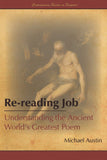 |
Re-reading Job: Understanding the World's Greatest Poem Retail: $20.95 |
 |
Search, Ponder, and Pray: A Guide to the Gospels Retail: $27.95 |
 |
Beholding the Tree of Life: A Rabbinic Approach to the Book of Mormon Retail: $21.95 |
 |
The Vision of All: Twenty-five Lectures on Isaiah in Nephi's Record Retail: $25.95 |
On the first day of Kofford: all Brant Gardner titles 30% off retail price! December 01 2016

Greg Kofford Books is pleased to offer 30% off of the following titles on December 1st. These special prices are only available for one day, so don't wait!
To get the 30% discount, simply enter the code BOOKOFMORMON (all caps) in the discount code box at check-out.
Orders over $50 qualify for free shipping. Also, local Utah customers can opt to pick up their order directly from our office in Sandy (select this option under the shipping menu).
For more information about the Twelve Days of Kofford holiday sales, click here.
Year in Review and the Year Ahead December 29 2015
2015 was another amazing year for Greg Kofford Books! Here is a recap of the year and a look ahead to what is coming in 2016 and beyond.
Award-winning Publications
Several Kofford titles won awards from the Mormon History Association and the Association for Mormon Letters in 2015:
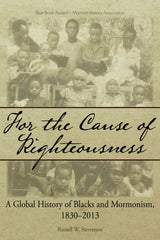 |
MHA Best Book Award For the Cause of Righteousness: A Global History of Blacks and Mormonism, 1830-2013 “Invaluable as a historical resource.” — Terryl L. Givens, author of Parley P. |
 |
MHA Best International Book Award Mormon and Maori “Unflinchingly honest yet unfailingly compassionate.” — Grant Underwood, |
 |
AML Religious Non-Fiction Award Re-reading Job: Understanding the Ancient World's Greatest Poem “A new gold standard for Mormon writings.” — Julie M. Smith, author, Search, |
All 2015 Titles
Here are all of the great titles that Greg Kofford Books published this past year:
 |
Mr. Mustard Plaster and Other Mormon Essays “Vibrant portraits of a kind and loving soul.” — Boyd J. Peterson, author of |
 |
Perspectives on Mormon Theology: Scriptural Theology Each essay takes up the relatively un-self-conscious work of reading a |
 |
Joseph Smith's Polygamy: Toward a Better Understanding “It is a book that will be read and discussed for years to come.” — Robert L. |
 |
Even Unto Bloodshed: An LDS Perspective on War “Indispensable for all future Mormon discussions of the subject.” — Daniel C. |
 |
William B. Smith: In the Shadow of a Prophet “Walker’s biography will become essential reading.” — Mark Staker, author of |
 |
Voices for Equality: Ordain Women and Resurgent Mormon Feminism “Timely, incisive, important.” — Joanna Brooks, co-editor of Mormon |
 |
Traditions of the Fathers: The Book of Mormon as History “Illuminating, prismatic views of the Book of Mormon.” — Mark Alan Wright, |
Looking Ahead at 2016 and Beyond
Here are a few eagerly-anticipated titles currently scheduled for the first part of 2016 and a look at what is in the works for the future:
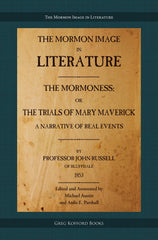 |
The Mormon Image in Literature Series The Mormoness; Or, The Trials Of Mary Maverick: A Narrative Of Real Events Published in 1853, the first American novel about the Mormons is also one of |
 |
The End of the World, Plan B: A Guide for the Future Environmental decline, political gridlock, war and rumors of war, decadence, |
Also forthcoming...
More volumes are in the works for our The Mormon Image in Literature, Contemporary Studies in Scripture, and Perspectives on Mormon Theology series.
Saints, Slaves, and Blacks by Newell G. Bringhurst, revised and updated
Lot Smith: Utah Hero, Arizona Colonizer by Carmen Smith and Talana Hooper
The Trek East: Mormonism Meets Japan, 1901-1968 by Shinji Takagi
Science the Key to Theology by Steven L. Peck
And much, much more...
Thank you for making 2015 exceptional and we are excited about 2016!
[FINISHED] Black Friday Sales: 30%-40% off all Book of Mormon titles! November 20 2015

40% off complete set of Second Witness (limited to first 100 sets)!
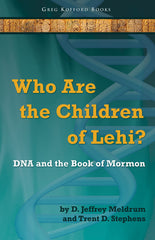
|
Who Are the Children of Lehi? “It may just cause you to think a little harder on the subject.” |
 |
Beholding the Tree of Life: “Breaks fresh ground in numerous ways.” |
 |
Traditions of the Fathers: “For those who are teaching the Book of Mormon in Sunday School next year ... Gardner’s book is a tremendous resource. It’s informative, cogent, and altogether worth reading.” |
 |
The Gift and Power: “Contributes new and exciting research” |
 |
Second Witness: “No other reference source will prove as thorough and valuable |
 |
Brigham Young University |
EXCLUSIVE OFFER:
40% off the complete Second Witness 6 Volume series!
(limited to first 100 sets)
Second Witness, Volumes 1 - 6
Complete Set: $249.70 hardcover
$149.82 Sale Price
LDS Theory of War in 3-Part Series October 08 2015

Kofford Books author Duane Boyce recently discussed the Mormon theology of war and violence in a three-part series at Meridian Magazine.
Boyce is the author of the Even unto Bloodshed: An LDS Perspective on War (2015), which has garnered the following praises:
“A careful and detailed argument against pacifism has long been needed, and it is hard to imagine someone doing a better job of it. The scholarship in this volume is impressive, and it is likely to be the definitive work on the subject for years to come. Truly a major accomplishment.” — K. Codell Carter, Professor of Philosophy, Brigham Young University
“Finally, we have a comprehensive and thorough discussion of war from an LDS perspective." — Royal Skousen, Professor of Linguistics, Brigham Young University, Editor, Book of Mormon Critical Text Project
In the first part of his series, Boyce discusses the question of pacifism vs. non-pacifism in LDS theology. He states:
"There are two fundamental views of war: pacifism, which argues that war cannot be justified and instead must be rejected as a matter of principle, and non-pacifism (of which just-war theory is an example), which argues that war is justified in certain circumstances.
It is easy to understand the appeal of both points of view. On one hand, all disciples of Christ detest violence; it is in the DNA of Christian embrace. And that gives pacifism a natural gravitational force: its appeal is both intrinsic and compelling. But an equally intrinsic and compelling influence in Christian DNA is the love of our families and of our brothers and sisters in general, and the obligation we feel to protect them from being brutalized and murdered.
The pull of these two moral forces creates a natural tension. The love of peace and the love of our brothers and sisters are both genuine, and both exert a natural influence on disciples of Christ. People end up leaning one way or the other, but it seems that everyone actually feels the pull of both.
The same tension seems to appear in the scriptures themselves."
Read part one: "Pacifism or Non-Pacifism? The First Great Question in Developing an LDS Theory of War."
In the second part of his series, Boyce examines the scriptural context of war:
"[One] view thought to support non-violence is the assertion that Book of Mormon wars occurred only because the Nephites were unrighteous. Every war they fought was completely unnecessary because the Lord promised Nephi that the Lamanites would never bother the Nephites if only the Nephites remained righteous (1 Nephi 2:23). We cannot, therefore, draw support for righteous conflict from the Nephites, since it turns out that the Nephites were always unrighteous when involved in conflict.
This claim, however—like the others—also appears to suffer when we examine the text more closely. It turns out that the Book of Mormon actually reports multiple occasions on which the Nephites suffered attack even though they were righteous—a feature of the record that straightforwardly disproves this categorical claim about them."
Read part two: "Do the Scriptures give us a Theory of War?"
In the third part of his series, Boyce discusses a theory of "just war" from an LDS perspective:
"Granted that the Lord abhors violence, what reason is there to think that he abhors all violence for the same reasons? Are all forms of violence the same? Do they all have the same moral character? Are the violence of a rapist and the violence of his victim the same? Do their violent acts have the same moral status? And are all forms of abhorrence-of-violence, then, the same?
And try this question. Why does scripture seem to countenance violence in some teachings/episodes and condemn it in others? Is there any reason to think the different cases and contexts are equivalent? Isn’t it more natural to wonder if there are differences between them and that that’s why they seem to teach different attitudes toward violence?"
Read part three: "Just War Theory and Key Gospel Texts"











